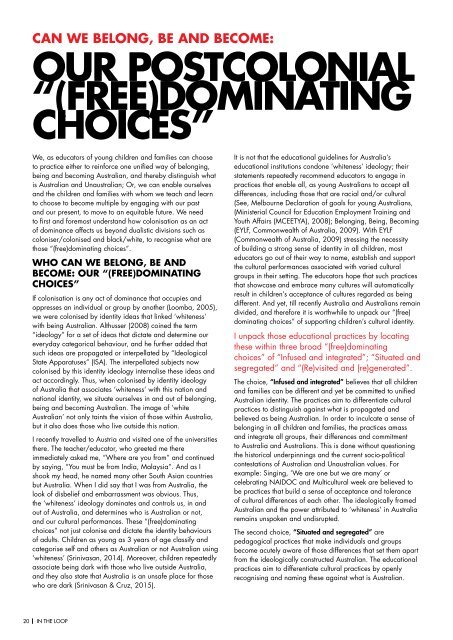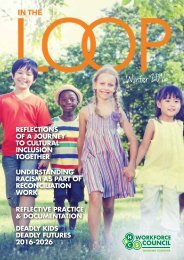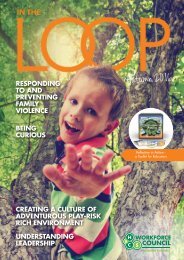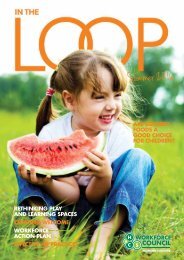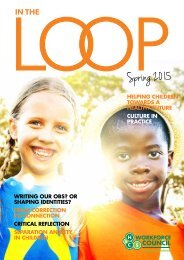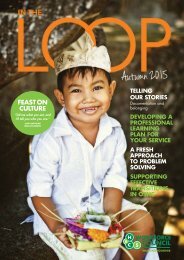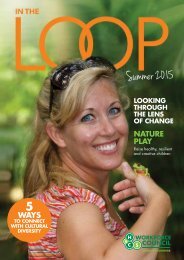The Loop December 2015 Web
You also want an ePaper? Increase the reach of your titles
YUMPU automatically turns print PDFs into web optimized ePapers that Google loves.
CAN WE BELONG, BE AND BECOME:<br />
OUR POSTCOLONIAL<br />
“(FREE)DOMINATING<br />
CHOICES”<br />
We, as educators of young children and families can choose<br />
to practice either to reinforce one unified way of belonging,<br />
being and becoming Australian, and thereby distinguish what<br />
is Australian and Unaustralian; Or, we can enable ourselves<br />
and the children and families with whom we teach and learn<br />
to choose to become multiple by engaging with our past<br />
and our present, to move to an equitable future. We need<br />
to first and foremost understand how colonisation as an act<br />
of dominance affects us beyond dualistic divisions such as<br />
coloniser/colonised and black/white, to recognise what are<br />
those “(free)dominating choices”.<br />
WHO CAN WE BELONG, BE AND<br />
BECOME: OUR “(FREE)DOMINATING<br />
CHOICES”<br />
If colonisation is any act of dominance that occupies and<br />
oppresses an individual or group by another (Loomba, 2005),<br />
we were colonised by identity ideas that linked ‘whiteness’<br />
with being Australian. Althusser (2008) coined the term<br />
“ideology” for a set of ideas that dictate and determine our<br />
everyday categorical behaviour, and he further added that<br />
such ideas are propagated or interpellated by “Ideological<br />
State Apparatuses” (ISA). <strong>The</strong> interpellated subjects now<br />
colonised by this identity ideology internalise these ideas and<br />
act accordingly. Thus, when colonised by identity ideology<br />
of Australia that associates ‘whiteness’ with this nation and<br />
national identity, we situate ourselves in and out of belonging,<br />
being and becoming Australian. <strong>The</strong> image of ‘white<br />
Australian’ not only taints the vision of those within Australia,<br />
but it also does those who live outside this nation.<br />
I recently travelled to Austria and visited one of the universities<br />
there. <strong>The</strong> teacher/educator, who greeted me there<br />
immediately asked me, “Where are you from” and continued<br />
by saying, “You must be from India, Malaysia”. And as I<br />
shook my head, he named many other South Asian countries<br />
but Australia. When I did say that I was from Australia, the<br />
look of disbelief and embarrassment was obvious. Thus,<br />
the ‘whiteness’ ideology dominates and controls us, in and<br />
out of Australia, and determines who is Australian or not,<br />
and our cultural performances. <strong>The</strong>se “(free)dominating<br />
choices” not just colonise and dictate the identity behaviours<br />
of adults. Children as young as 3 years of age classify and<br />
categorise self and others as Australian or not Australian using<br />
‘whiteness’ (Srinivasan, 2014). Moreover, children repeatedly<br />
associate being dark with those who live outside Australia,<br />
and they also state that Australia is an unsafe place for those<br />
who are dark (Srinivasan & Cruz, <strong>2015</strong>).<br />
It is not that the educational guidelines for Australia’s<br />
educational institutions condone ‘whiteness’ ideology; their<br />
statements repeatedly recommend educators to engage in<br />
practices that enable all, as young Australians to accept all<br />
differences, including those that are racial and/or cultural<br />
(See, Melbourne Declaration of goals for young Australians,<br />
(Ministerial Council for Education Employment Training and<br />
Youth Affairs (MCEETYA), 2008); Belonging, Being, Becoming<br />
(EYLF, Commonwealth of Australia, 2009). With EYLF<br />
(Commonwealth of Australia, 2009) stressing the necessity<br />
of building a strong sense of identity in all children, most<br />
educators go out of their way to name, establish and support<br />
the cultural performances associated with varied cultural<br />
groups in their setting. <strong>The</strong> educators hope that such practices<br />
that showcase and embrace many cultures will automatically<br />
result in children’s acceptance of cultures regarded as being<br />
different. And yet, till recently Australia and Australians remain<br />
divided, and therefore it is worthwhile to unpack our “(free)<br />
dominating choices” of supporting children’s cultural identity.<br />
I unpack those educational practices by locating<br />
these within three broad “(free)dominating<br />
choices” of “Infused and integrated”; “Situated and<br />
segregated” and “(Re)visited and (re)generated”.<br />
<strong>The</strong> choice, “Infused and integrated” believes that all children<br />
and families can be different and yet be committed to unified<br />
Australian identity. <strong>The</strong> practices aim to differentiate cultural<br />
practices to distinguish against what is propagated and<br />
believed as being Australian. In order to inculcate a sense of<br />
belonging in all children and families, the practices amass<br />
and integrate all groups, their differences and commitment<br />
to Australia and Australians. This is done without questioning<br />
the historical underpinnings and the current socio-political<br />
contestations of Australian and Unaustralian values. For<br />
example: Singing, ‘We are one but we are many’ or<br />
celebrating NAIDOC and Multicultural week are believed to<br />
be practices that build a sense of acceptance and tolerance<br />
of cultural differences of each other. <strong>The</strong> ideologically framed<br />
Australian and the power attributed to ‘whiteness’ in Australia<br />
remains unspoken and undisrupted.<br />
<strong>The</strong> second choice, “Situated and segregated” are<br />
pedagogical practices that make individuals and groups<br />
become acutely aware of those differences that set them apart<br />
from the ideologically constructed Australian. <strong>The</strong> educational<br />
practices aim to differentiate cultural practices by openly<br />
recognising and naming these against what is Australian.<br />
20<br />
IN THE LOOP


